| Takht-e Foulad | |
|---|---|
تخته فولاد | |
 The main iwan portal gateway to Takht-e Foulad cemetery | |
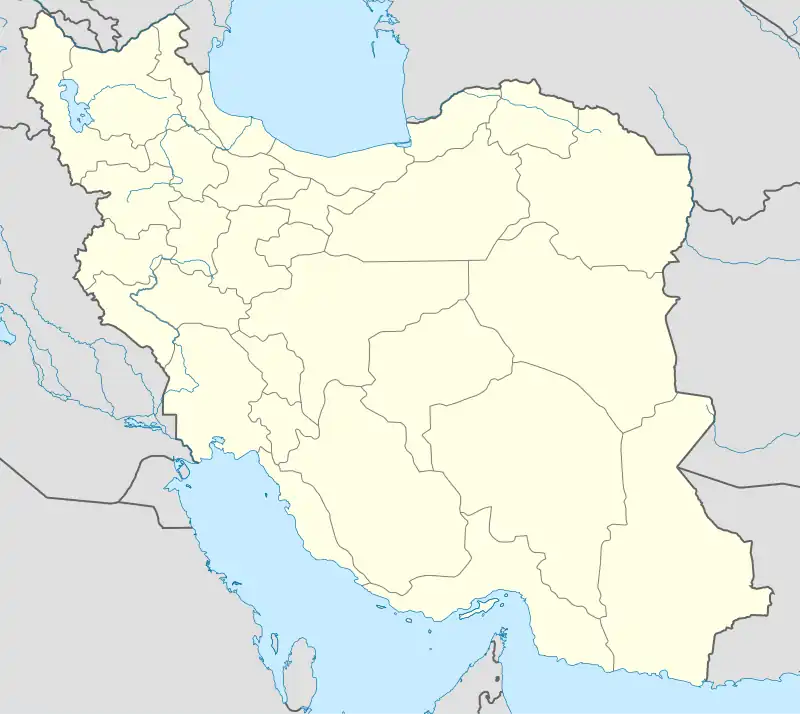 Shown within Iran | |
| General information | |
| Type | cemetery |
| Address | Isfahan Province, Isfahan, Takht Foulad, Valeh St, Iran |
| Town or city | Isfahan |
| Country | Iran |
| Coordinates | 32°37′39″N 51°40′59″E / 32.62750°N 51.68306°E |
| Known for | Containing the mausoleums of prominent clerics, scholars and ascetics, as well as the graves of martyrs who were killed in the Iranian Revolution. |
Takht-e Foulad (Persian: تخته فولاد), also known as Lissanul Arz is a historical cemetery in Isfahan, Iran. It is a large funerary complex that includes several historic mausoleums, mosques, tekyehs, sub-cemeteries and standalone graves.[1][2]
History
The exact origins of the cemetery are not known, but some historians have theorised that it may have pre-Islamic origins.[2] During the rule of the Mongol Ilkhanate in the 14th century, the mausoleum of Baba Rokneddin Shirazi was built, and the cemetery was named after him.[2] The cemetery subsequently became a place for Sufi dervishes to have mystical gatherings.[2]

The cemetery was expanded in the Safavid period, under the rule of Suleiman I of Persia.[2] But later on during the rule of Safavid Shah Soltan Hoseyn, many of the mausoleums from the Ilkhanid era were demolished, under the orders of Mohammad-Baqer Majlesi, the Shaykhul Islam hired by the ruler. The Sufis and their dervishes were also banned from visiting the cemetery, regardless whether they were Shi'ite or not.[2] During the rule of Nader Shah Afshar, the cemetery was largely ignored, save for a small number of burials.[2]
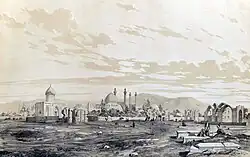
During the Qajar period, Fath-Ali Shah Qajar built a tekyeh in the cemetery, which he dedicated to his mother.[2] In the 20th century, however, Mass'oud Mirza Zell-e Soltan, the Qajar prince who governed Isfahan, demolished several Safavid-era structures in the cemetery.[2] Later on in the same century, in the 1980s, a sub-cemetery was established around the grave of cleric Abolhassan Shamsabadi, and in the cemetery were buried those who were killed in the Haft-e Tir Bombing and Iranian Revolution.[3]
During Pahlavi rule, the cemetery had become full. Locals were then forbidden from carrying out any further burials.[2] They were still allowed to visit the sites in the cemetery, however.[2]
Landmarks in the cemetery
Mausoleum of Baba Rokneddin
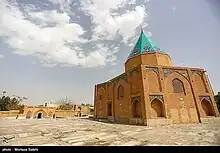
Baba Rukn al-Din, or Baba Rokneddin, was one of the most prominent Persian Sufis in the 14th century. He died in 1367,[4] and the mausoleum was built during the Ilkhanid era.[2] It had fallen into disrepair later on, and was later restored during the Safavid era under Shah Abbas I.[5][6] It is the only structure from the Ilkhanid era to survive till modern day.[2]
Khatoon Abadi Mausoleum

One of the tekyeh buildings located in the cemetery. Clerics belonging to the Khatoon Abadi family are buried in there, an example being Mohammed Hossein Khatunabadi, a Shi'ite Hadith scholar.[1] There is a small cellar underneath the tomb, speculated to be a place where the ascetic-inclined Khatunabadi secluded himself and meditated.[1]
Mausoleum of Mir Fendereski
The burial place of the famous mystic and scholar in the Safavid era, Mir Fendereski.[1] His grave has a stone tombstone, which bears the date 1640, the year he died. Next to the grave, a ghazal of the poet Hafez, in the Nastaliq script style, made with stucco, by Mir Emad Hassani, is visible on the wall of the place.
Mausoleum of Agha Hossein Khansari

Agha Hossein Khansari was a very influential scientist and scholar in the court of the Safavid ruler Suleiman I.[7] His mausoleum is topped with a single cupola dome, and it is the only mausoleum in the cemetery which was built for a scientist or engineer.[8]
Roknolmolk Mosque
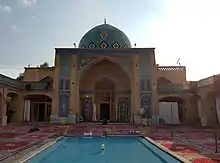
It was formerly known as the Aksa Mosque. The mosque was built in the Qajar era, and is at the edge of the Takht-e Foulad cemetery. The mosque has a room that contains the graves of both Roknolmolk and his wife, located near to the entrance, as well as a mausoleum for clerics of the Kalbasi family.
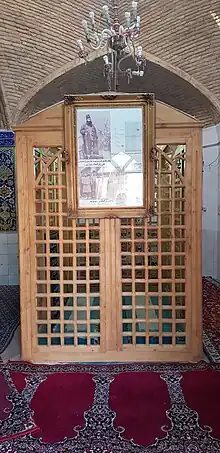
Mohammad Jafar Abadei Tekyeh
Established by the Qajar viceroy, Roknolmolk, named for the Shi'ite scholar, Mohammad Ja'far Abadei.[9] It is adjacent to the Roknolmolk Mosque.
Golestan-e Shohada Cemetery

This smaller sub-cemetery is attached to the cemetery of Takht-e Foulad.[10][11] The cemetery is where several martyrs are buried, hence the name Shohada, is a Persianized form of the word Shuhada which means Martyr in Arabic. One of the first burials in the cemetery is that of Abolhassan Shamsabadi. Those killed in the Haft-e Tir Bombing of 1981, and those who lost their lives during the Iranian Revolution are buried here as well.[12]
Within the cemetery, there is also a cenotaph attributed as a grave to the Biblical prophet Joshua[13][14] however there is no evidence that he is buried there.
See also
- List of historical structures in Isfahan for a list of other mausoleums, mosques and other Islamic heritage in the Isfahan Province
- List of mausoleums in Iran for a complete list of mausolea in Iran.
References
- 1 2 3 4 https://www.kojaro.com/attraction/7466-%D9%82%D8%A8%D8%B1%D8%B3%D8%AA%D8%A7%D9%86-%D8%AA%D8%AE%D8%AA-%D9%81%D9%88%D9%84%D8%A7%D8%AF/
- 1 2 3 4 5 6 7 8 9 10 11 12 13 "گورستان تخت فولاد؛ تاریخچه + راه های دسترسی - مجله مِستر بلیط" (in Persian). 28 December 2022. Retrieved 4 December 2023.
- ↑ sahebnews.ir https://sahebnews.ir/90528/%D9%82%D8%B7%D8%B9%D9%87-%D9%87%D8%A7%DB%8C-%DA%AF%D9%84%D8%B3%D8%AA%D8%A7%D9%86-%D8%B4%D9%87%D8%AF%D8%A7.htm. Retrieved 10 November 2023.
{{cite web}}: Missing or empty|title=(help) - ↑ "Bābā Rukn al-Dīn Shīrāzī". Encyclopaedia Islamica. doi:10.1163/1875-9831_isla_com_0000009. Retrieved 10 November 2023.
- ↑ Mahdawi. Tadhkirat al-qubūr. p. 153.
- ↑ Hosseyn Yaghoubi (2004). Arash Beheshti (ed.). Rāhnamā ye Safar be Ostān e Esfāhān(Travel Guide for the Province Isfahan) (in Persian). Rouzane. p. 121. ISBN 964-334-218-2.
- ↑ Hosseyn Yaghoubi (2004). Arash Beheshti (ed.). Rāhnamā ye Safar be Ostān e Esfāhān(Travel Guide for the Province Isfahan) (in Persian). Rouzane. p. 121. ISBN 964-334-218-2.
- ↑ Hosseyn Yaghoubi (2004). Arash Beheshti (ed.). Rāhnamā ye Safar be Ostān e Esfāhān(Travel Guide for the Province Isfahan) (in Persian). Rouzane. p. 121. ISBN 964-334-218-2.
- ↑ "رکن الملک (سلیمان)".
- ↑ https://web.archive.org/web/20160905111445/http://isfahan.ir/ShowPage.aspx?page_=form&order=show&lang=1&sub=48&PageId=5942&codeV=1&tempname=ISFGolestan
- ↑ "خبرگزاری فارس - تخت فولاد؛ قدیمیترین قبرستان بعد از وادیالسلام+تصاویر". خبرگزاری فارس. 19 March 2013. Retrieved 4 December 2023.
- ↑ sahebnews.ir https://sahebnews.ir/90528/%D9%82%D8%B7%D8%B9%D9%87-%D9%87%D8%A7%DB%8C-%DA%AF%D9%84%D8%B3%D8%AA%D8%A7%D9%86-%D8%B4%D9%87%D8%AF%D8%A7.htm. Retrieved 10 November 2023.
{{cite web}}: Missing or empty|title=(help) - ↑ "تجمع در اعتراض به ساختوساز در گلستان شهدای اصفهان". اقتصادنیوز (in Persian). 28 May 2015. Retrieved 10 November 2023.
- ↑ "خبرگزاری فارس - تخت فولاد؛ قدیمیترین قبرستان بعد از وادیالسلام+تصاویر". خبرگزاری فارس. 19 March 2013. Retrieved 4 December 2023.